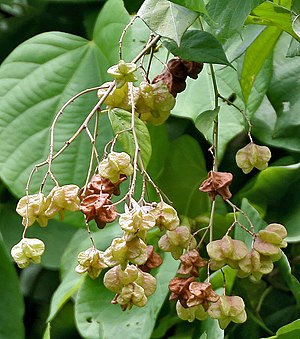Note: This is a project under development. The articles on this wiki are just being initiated and broadly incomplete. You can Help creating new pages.
Difference between revisions of "Kleinhovia hospita - Guest tree"
(Created page with "thumb|right|''Kleinhovia'', ''Guest tree'' '''Guest tree''' or '''Kleinhovia hospita''' is an evergreen, tropical tree native to Indonesia, Mala...") |
(No difference)
|
Revision as of 12:13, 6 January 2017
Guest tree or Kleinhovia hospita is an evergreen, tropical tree native to Indonesia, Malaysia and other parts of tropical Asia. It is monotypic, being the only species in the genus Kleinhovia.
Contents
Description
K. hospita is an evergreen, bushy tree growing up to 20 m high, with a dense rounded crown and upright pink sprays of flowers and fruits. Leaves are simple and alternate; stipules are ensiform to linear, about 8 mm long; petioles are 2.5–30 cm long; the leaf-blade is ovate to heart-shaped, glabrous on both sides, with the apex pointed. Secondary veins occur in 6-8 pairs, palmately nerved.
The flowers of K. hospita are terminal, in loose panicles protruding from the crown; flowers are about 5 mm wide, coloured pale pink; pedicels are 2–10 mm long; bracteoles are lanceolate, 2–4 mm long, pubescent; gynandrophores are 4–7 mm long, pubescent; there are 5 sepals, linear lanceolate, 6–8 mm long, pink, tomentose; 5 petals, inconspicuous, the upper one being yellow; 15 stamens, monaldelphous, 8–15 mm long, staminal tube broadly campanulate, adanate to gynandrophore, 5-lobed, each lobe having 3 anthers and alternating with staminodes; the anthers are sessile and extrorse; pistil occur with a 5-celled, pilose ovary, one style and a capitate, with a 5-lobed stigma. K. hospita flowers throughout the year.
Fruit production starts early, often in the third year after planting. The fruit of K. hospita are rounded, 5-lobed, thin-walled, membranous capsules, 2-2.5 cm in diameter, loculicidally dehiscent, each locule having 1-2 seeds. The seeds are globose, whitish, warty and exalbuminous. The fruits are more conspicuous than the flowers because of their abundance and size.
Uses
- K. hospita is used as a traditional medicine in parts of Malaya, Indonesia and Papua New Guinea to treat scabies.
- The bark and leaves used as hairwash for lice, while the juice of the leaves are used as an eyewash.[citation needed] Young leaves are eaten as a vegetable. Bast fibres are used for making ropes used for tying or for tethering livestock.[1](clarification needed)
- Guest Tree is used as a traditional medicine in parts of Malaya, Indonesia and Papua New Guinea to treat scabies.[2](clarification needed)
- K. hospita is used for ornamental purposes: the attractiveness of the pink panicles accounts for its spread as an ornamental.
